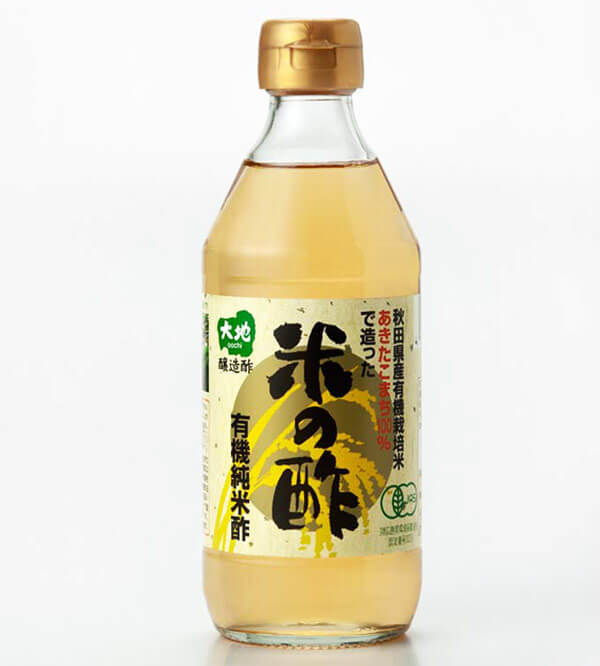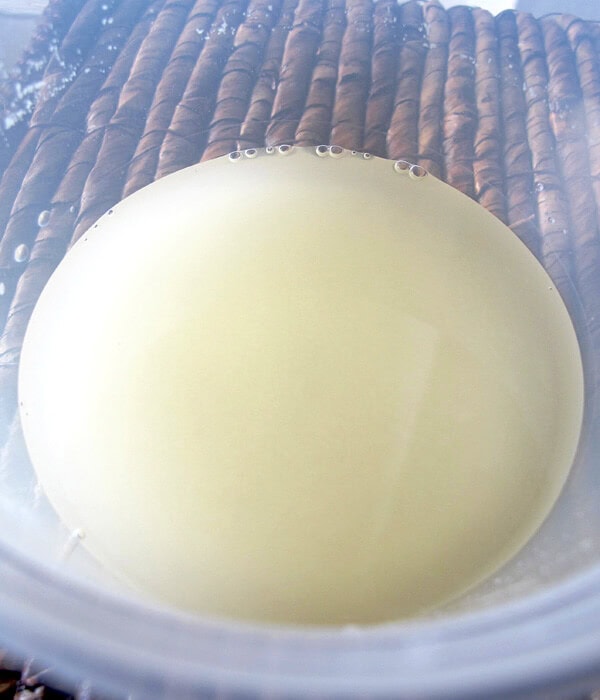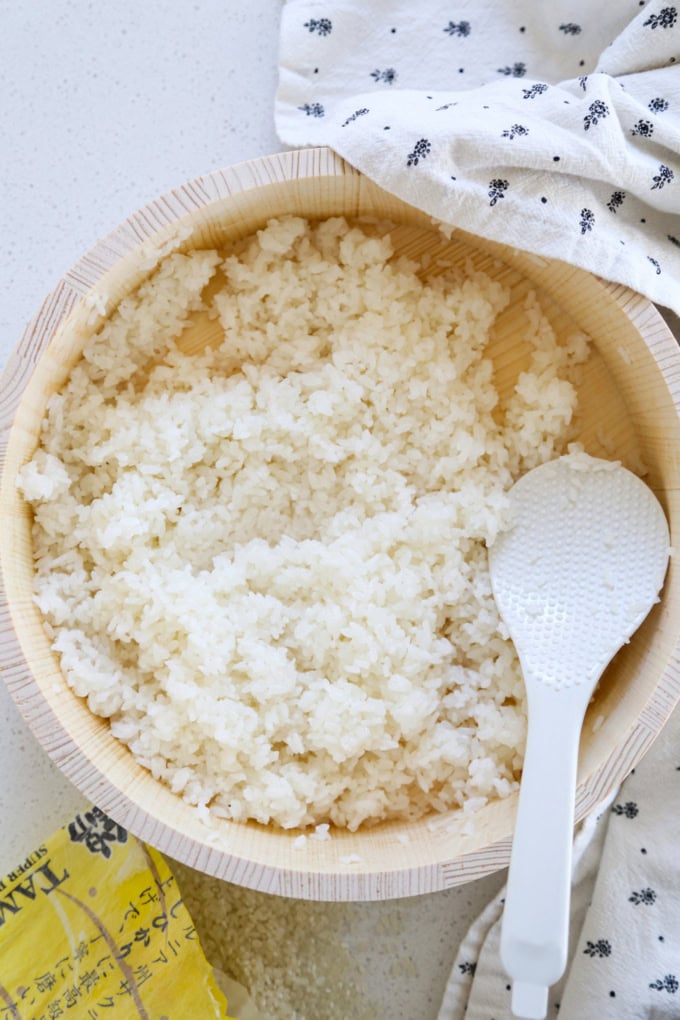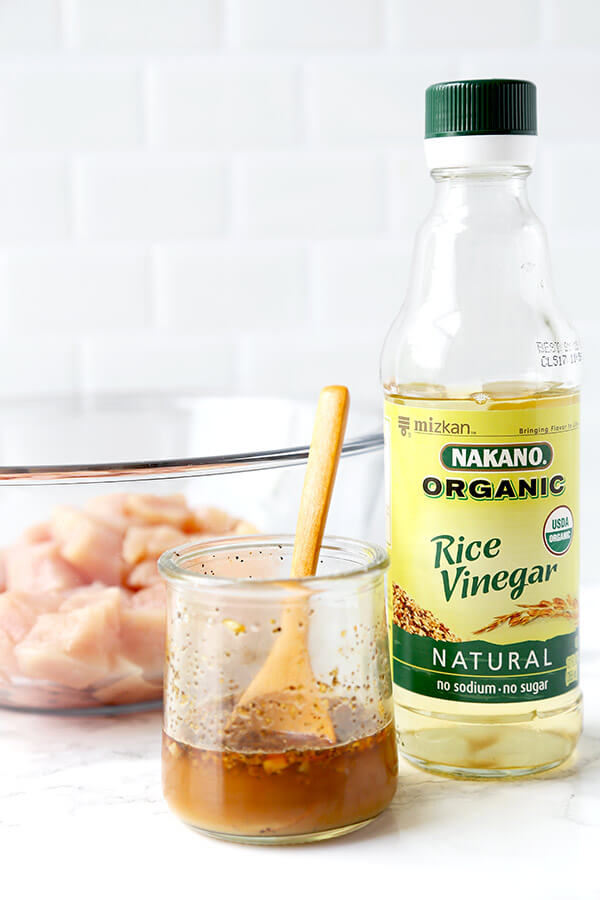Rice vinegar is an essential ingredient in Japanese cooking. With its tangy and delicate flavor, it can add a refreshing element to salads and cold summer dishes, pungency to stews and stir fries, and a biting taste to pickles and marinades.

What is Rice Vinegar?
Rice vinegar, or Japanese Komezu (米酢), is a mild and sweet vinegar made from rice and is used in a variety of ways – from pickling to simmering. Popular in Japan, China, Korea and Vietnam, this ingredient is made from fermented rice. It is also known as rice wine vinegar because the sugars in rice are first converted into alcohol (rice wine), then into acid (vinegar).
There are four different varieties of rice vinegar:
1. White rice vinegar. Ranging in color from clear to yellow, this is the most common type and what most recipes call for.
2. Brown rice vinegar. Because it is made from unpolished brown rice, this rice vinegar has a warmer color and can usually be used interchangeably with its white counterpart.
3. Black rice vinegar. Rich in umami and somewhat smoky-tasting, this ingredient is made by combining black glutinous rice with other grains such as sorghum, wheat or millet. It is often used in Chinese stir fries or as a dipping sauce.
4. Red rice vinegar. This variety is made with red yeast rice, and sometimes sorghum and barley. It has similar uses as black rice vinegar.

Rice Vinegar vs White Vinegar
Even though white rice vinegar and white vinegar are similar in color, their flavors are totally opposite. Rice vinegar is sweet and delicate, with a mild acidity, while white vinegar is bitter and sharp. White vinegar can be made from a variety of grains like wheat or corn, and even potatoes.
It is mostly used in Western cuisine for salad dressings or pickling brine. Some people also like to use white vinegar as an inexpensive natural household cleaner. Please note that white vinegar is not an appropriate substitute for rice vinegar. Scroll down to find out which vinegar is the best substitute.
Chinese Rice Vinegar vs Japanese Rice Vinegar
Also called komezu, Japanese rice vinegar is very mild and mellow. It’s easy to find in grocery stores under brand names such as Marukan, House Foods, Mizkan, and Kikkoman.
Seasoned rice vinegar (awasezu) is a little different than plain rice vinegar in that it is made by combining sake, salt, sugar and plain rice vinegar. It is most often used to add flavor to sushi rice (vinegared rice) but can also be used to flavor salads.
Kurozu is a lighter form of black vinegar produced in the Kagoshima prefecture, which is located in the South of Japan. Left to ferment in the sun for several years, this vinegar is sought after for its medicinal properties, but also for its intense yet subtle flavor.
Chinese rice vinegars on the other hand are sharper in flavor than the Japanese types, and come in a variety of colors (white, red and black). Black vinegar, with its deep smoky flavor, is especially popular in China.

How to Use Rice Vinegar
The mild and slightly sweet character of rice vinegar makes it a very versatile ingredient in both Asian and Western dishes. It can be used on its own or mixed with other ingredients.
- Sushi rice. You can make sushi rice from scratch using my recipe here, or use seasoned rice vinegar. This gives the rice a sweet and tangy taste and also prevents it from spoiling.
- Asian sauces. One of the best known is Ponzu (click here to learn how to make ponzu from scratch), which is widely used as a dipping sauce for sashimi or tataki. It is made by combining rice vinegar, mirin, dashi, sometimes soy sauce, and a mixture of yuzu and other citrus fruits. Rice vinegar is also easy to combine with ingredients that are commonly found in Asian cuisine to create cooking sauces such as stir fry sauces.
- Dressings. You can substitute rice vinegar in your usual salad dressing by using a 2:1 or a 1:1 ratio of rice vinegar to oil. It also pairs well with other Asian ingredients like sesame oil, soy sauce, and ginger.
- Marinades. The acids in rice vinegar, just like any other vinegar in marinade recipes, are good at tenderizing foods and eliminating odors in meat and seafood.
- Pickling. It is a great ingredient for making tsukemono (Japanese pickles) or sunomono, vinegar-based dishes commonly served as side dishes (often Japanese cucumber salad). You can also use rice vinegar to pickle vegetables such as cucumber, carrots, daikon, bell peppers, or cauliflowers.
Substitute for Rice Vinegar
If you don’t happen to have rice vinegar in your pantry and the recipe you are following calls for some, no need to panic! There are many options when it comes to finding rice vinegar alternatives. Here are the best ones:
- Apple cider vinegar. This type of vinegar is made from apple cider that has undergone fermentation. Its subtle sweetness is similar to rice vinegar, making it a perfect 1:1 substitute for salad dressings and sauces. To make it as sweet as rice vinegar, you can add ¼ teaspoon of sugar per tablespoon of apple cider vinegar. Please note that apple cider vinegar is not the best choice for pickling, as its subtle apple flavor may overpower the dish.
- White wine vinegar. This one is made through the fermentation of white wine. It is stronger and fruitier than rice vinegar, but not particularly sweet. It can be a good rice vinegar replacement in meaty dishes like stews and sauces or in vinaigrettes in a 1:1 ratio. Like apple cider vinegar, adding ¼ teaspoon of sugar per tablespoon of white wine vinegar will help it match the sweetness of rice vinegar.
- Balsamic vinegar. No need to add sugar to this type of vinegar, as it already has plenty of sweetness! Since it has a much deeper flavor than rice vinegar, it is best used in recipes that don’t require something subtle.
- Sherry vinegar. Because it has a similar balance of acidity and sweetness, sherry vinegar is an excellent substitute for rice vinegar. Despite its nuttier flavor, you can use it in any recipe (in equal amounts). It can also be used to pickle vegetables.
- Champagne vinegar. This vinegar is made by fermenting champagne. Its light and delicate flavor makes it a perfect option for seafood dishes, marinades and dipping sauces. When out of rice vinegar, you can replace it with champagne vinegar in a 1:1 ratio.
- Lemon or lime juice. Because they are both acidic, and therefore can mimic the acidity of rice vinegar, these citrus juices can add a bit of tang to salad dressings or sauces. But before you make the swap in a 2:1 ratio, make sure you don’t mind your final dish having a bit of citrus taste.















